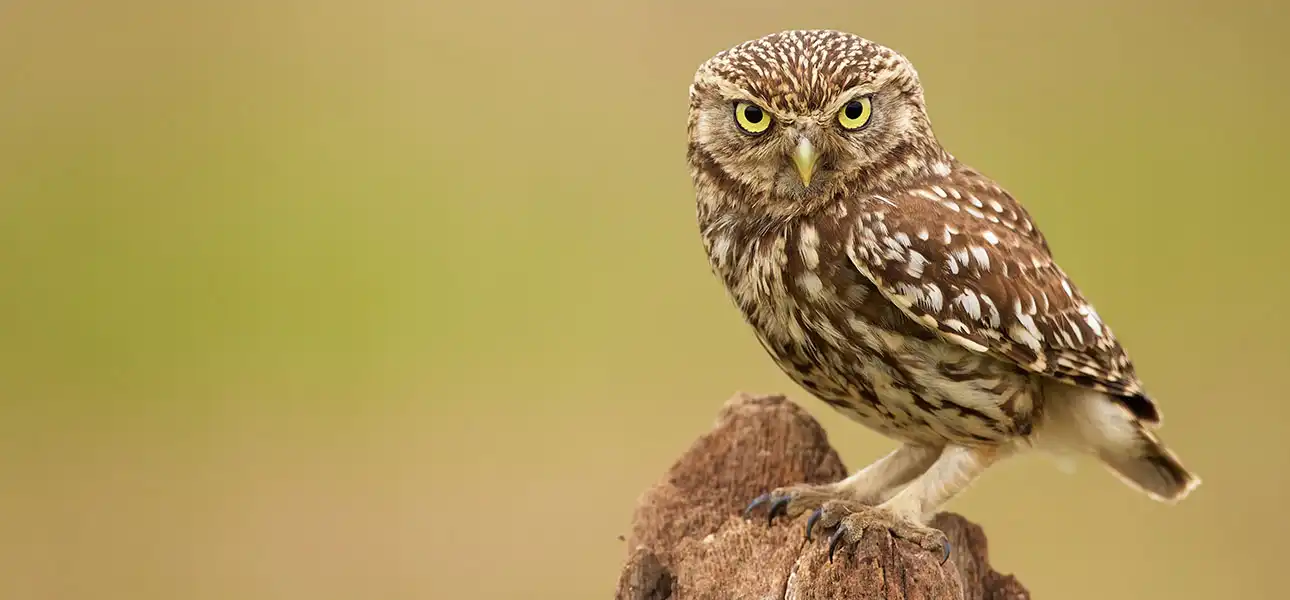
A familiar denizen of the archetypal rural landscape of sweeping fields and old trees, Little Owl is actually a recent addition to the bird life of the UK. Introduced to several parts of England in the 1870s and 1880s, the numbers rose, and the species spread until it was found in all parts of lowland England and Wales. Unlike many introduced species, Little Owl seems to be one that is generally welcomed, and it does seem to have found a niche in the British avifauna that was previously unoccupied. Being a species that hunts during the day and at dusk, as well as a bird that habitually sits out in the open, often on exposed perches such as telegraph poles or even road signs, and has a characteristic dumpy, flat-headed appearance they are easily spotted. Small they may be, but they make up for this with attitude. When spotted, rather than flying away, the Little Owl is just as likely to turn its head slowly towards you and stare until you leave its territory!
Key facts
Common name: Little Owl
Scientific name: Athene noctua
Habitat: Man-made landscapes, being mostly linked with farmland, rural areas, hedges and parkland
Diet: Insects and small mammals, reptiles, amphibians and even birds
Size: Average 22cm, wingspan 56cm. Weight averages 180g, although females are significantly larger than male
Status: Introduced, resident breeder
Population size: 3,600 pairs
Conservation status: Not accessed as not native, but rapid decline highlighted by annual monitoring
Lifespan
The average lifespan is 3 years. Adults have a 65% year-to-year survival. First year survival is just 30%. The oldest known wild bird was almost 14 years old (ringing recovery).
Nesting
Little Owls are cavity nesters, and can be found in tree holes, but they will also make use of buildings and walls, man-made structures and will readily take to nest boxes, both external and internal to buildings. Ground nesting occurs in certain areas, with abandoned Rabbit burrows a favourite.
Number of eggs: 3-4
Incubation: 29-31 days
Fledging time: 37-40 days
Habitat and Distribution
A familiar owl of England and Wales, there are very few breeding records in southern Scotland and Little Owls are only a vagrant to Ireland. As a highly sedentary bird, winter and breeding season distribution are almost identical. Little Owl is principally a species of man-made landscapes, being mostly linked with farmland, rural areas, hedges and parkland.
Movements
Little Owls are remarkably sedentary, with most fledglings not moving more than 20 km before breeding themselves. Before being introduced there were very occasional records of vagrant Little Owls from continental Europe, but British-ringed birds are very stay-at-home.
Feeding
Being small, Little Owls feed heavily on invertebrates, with insects and earthworms making up a large proportion of the diet, but these pugnacious little birds will also tackle small mammals, reptiles, amphibians and even birds. Most food is caught from a stoop, but pursuit on foot is frequent, and Little Owls are known to cache food in times of plenty.

